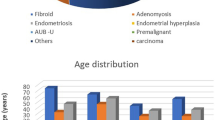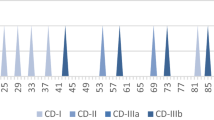Abstract
This was a retrospective study to review the uptake and outcomes of robotic gynaecological surgery in England between 1st April 2006 and 31st March 2018, analysing Hospital Episode Statistics form National Health Service hospitals in England. Women aged 18 years and above who had elective gynaecological surgery were included and those who had undergone robotic gynaecology surgery were included. Robotic gynaecological procedures were defined as procedures that used a robotic minimal access approach for hysterectomy, adnexal surgery and urogynaecological surgery (sacrocolpopexy, sacrohysteropexy and colposuspension). Numbers of procedures were reviewed by year and mapped to the 44 NHS healthcare regions. Length of stay (nights in hospital), laparotomy (conversion during primary procedure or after return to theatre for management of complication), and 30-day emergency readmission rates were calculated by year and procedure type. Overall 527,217 elective gynaecological procedures were performed in the English NHS (1st April 2006 and 31st March 2018), of which 4384 (0.83%) were performed with robotic assistance (3864 (88%) hysterectomy, 706 (16%) adnexal surgery, 192 (4%) urogynaecological surgery). There was gradual rise in the uptake of robotic surgery but there was a marked geographical variation. Median (IQR) length of stay (LOS) was 1(1–2) night, laparotomy rate was 0.3% and 30-day emergency readmission rate was 4.7%. LOS was statistically, but not clinically, different across time. Other outcomes did not differ by year. Robotic gynaecological procedures are increasingly being used in the English NHS, predominantly for hysterectomy, although in small proportions (2.6% in the most recent study year). There was wide geographical variation in robotic uptake across England and overall, outcomes were comparable to those reported in other countries.



Similar content being viewed by others
Data availability
Study data and material are available and could be shared if needed following appropriate approvals.
Code availability
OPCS-4 surgical procedure codes used in the study are included in the supplementary material. OPCS-4.8 is a publically available document and is appropriately referenced in text.
References
Intuitive Surgical I (2005) Intuitive Surgical Receives FDA Clearance for Gynecological Laparoscopic Procedures. https://isrg.intuitive.com/node/7541/pdf. Accessed 26th Sep 2019
Surgical I (2017) Intuitive Surgical Investor Presentation Q3:2017
Intuitive Surgical I Da Vinci systems. https://www.intuitive.com/en-us/products-and-services/da-vinci/systems##. Accessed 26th Sep 2019
Moss E, Sarhanis P, Ind T, Smith M, Davies Q, Zecca M (2020) The impact of obesity on surgeon ergonomics in robotic and straight stick laparoscopic surgery. J Minim Invasive Gynecol 27:1063–69. https://doi.org/10.1016/j.jmig.2019.07.009
Yohannes P, Rotariu P, Pinto P, Smith AD, Lee BR (2002) Comparison of robotic versus laparoscopic skills: is there a difference in the learning curve? Urology 60(1):39–45. https://doi.org/10.1016/S0090-4295(02)01717-X
Lawrie TA, Liu H, Lu D, Dowswell T, Song H, Wang L, Shi G (2019) Robot‐assisted surgery in gynaecology. Cochrane Database of Systematic Reviews (4). doi:https://doi.org/10.1002/14651858.CD011422.pub2
Jayakumaran J, Patel S, Gangrade B, Narasimhulu D, Pandian S, Silva C (2017) Robotic-assisted laparoscopy in reproductive surgery: a contemporary review. J Robot Surg 11(2):97–109. https://doi.org/10.1007/s11701-017-0682-4
Miklos JR, Moore RD, Chinthakanan O (2015) Laparoscopic and Robotic-assisted Vesicovaginal Fistula Repair: A Systematic Review of the Literature. The Journal of Minimally Invasive Gynecology 22(5):727–736. https://doi.org/10.1016/j.jmig.2015.03.001
Digital N Hospital Episodes Statistics
Digital N Hospital Episodes Statistics—Admitted patient care
Digital N (2017) National Clinical Coding Standards OPCS-4 (2017).
Digital N (2018) Hospital Admitted Patient Care activity, 2016–17: procedures and interventions. Accessed 10th July 2018
digital N (2018) Hospital Episode Statistics Data Dictionary. https://digital.nhs.uk/data-and-information/data-tools-and-services/data-services/hospital-episode-statistics/hospital-episode-statistics-data-dictionary. Accessed 22nd Aug 2018
England N Local sustainability and transformation partnerships. https://www.england.nhs.uk/integratedcare/stps/view-stps/. Accessed 26th Sep 2019
NHS (2016) Sustainability and Transformation Plan footprints. https://www.england.nhs.uk/wp-content/uploads/2016/02/stp-footprints-march-2016.pdf.
Digital N (2018) Hospital Admitted Patient Care Activity, 2017–18
Digital N Data Quality Assurance NHS Digital https://digital.nhs.uk/data-and-information/data-tools-and-services/data-services/data-quality. Accessed 1st May 2020
Andy Boyd RC, Leigh Johnson, Shirley Simmonds, Holly Syddall, Leo Westbury, et al. (2018) Understanding Hospital Episode Statistics (HES). CLOSER, Institute of Edicationn, University College London
Thorn JC, Turner EL, Hounsome L, Walsh E, Down L, Verne J, Donovan JL, Neal DE, Hamdy FC, Martin RM, Noble SM (2016) Validating the use of Hospital Episode Statistics data and comparison of costing methodologies for economic evaluation: an end-of-life case study from the Cluster randomised triAl of PSA testing for Prostate cancer (CAP). BMJ Open 6. doi:https://doi.org/10.1136/bmjopen-2016-011063
Roger EM (2003) Diffusion of Innovations, 5th edn. Free Press, New York
Chung G, Hinoul P, Coplan P, Yoo A (2020) Trends in the diffusion of robotic surgery in prostate, uterus, and colorectal procedures: a retrospective population-based study. J Robot Surg. https://doi.org/10.1007/s11701-020-01102-6
Wright GP, Wolf AM, Chung MH (2015) The rise of the machines: examining national trends in robotic surgery. J Am Coll Surg 221(4):e90–e90. https://doi.org/10.1016/j.jamcollsurg.2015.08.135
Stewart CLIP, Melstrom KA et al (2019) Robotic surgery trends in general surgical oncology from the National Inpatient Sample. SurgEndosc 33(8):2591–2601. https://doi.org/10.1007/s00464-018-6554-9
Damle AMDMBA, Damle RNMDMS, Flahive JMMS, Schlussel ATDO, Davids JSMD, Sturrock PRMD, Maykel JAMD, Alavi KMDMPH (2017) Diffusion of technology: trends in robotic-assisted colorectal surgery. Am J Surg 214(5):820–824. https://doi.org/10.1016/j.amjsurg.2017.03.020
Papalekas E, Fisher J (2018) Trends in Route of Hysterectomy after the Implementation of a Comprehensive Robotic Training Program. Minimally Invasive Surgery 2018. doi:https://doi.org/10.1155/2018/7362489
Wilson CB (2006) Adoption of new surgical technology. BMJ 332(7533):112–114. https://doi.org/10.1136/bmj.332.7533.112
Marcus HJH-HA, Payne CJ et al (2017) Trends in the diffusion of robotic surgery: a retrospective observational study. Int J Med Robot 13(4):e1870. https://doi.org/10.1002/rcs.1870
Stewart CL, Dumitra S, Nota C, Ituarte PHG, Melstrom LG, Woo Y, Singh G, Fong Y, Nathan H, Warner SG (2019) Hospital factors strongly influence robotic use in general surgery. Surgery 166(5):867–872. https://doi.org/10.1016/j.surg.2019.05.008
Lee M-TG, Chiu C-C, Wang C-C, Chang C-N, Lee S-H, Lee M, Hsu T-C, Lee C-C (2017) Trends and outcomes of surgical treatment for colorectal cancer between 2004 and 2012- an analysis using national inpatient database. Sci Rep 7(1):2006–2008. https://doi.org/10.1038/s41598-017-02224-y
Esen E, Aytac E, Ozben V, Bas M, Bilgin IA, Aghayeva A, Baca B, Hamzaoglu I, Karahasanoglu T (2019) Adoption of robotic technology in Turkey: A nationwide analysis on caseload and platform used. The international journal of medical robotics + computer assisted surgery 15 (1):e1962-n/a. doi:https://doi.org/10.1002/rcs.1962
Juo Y-Y, Mantha A, Abiri A, Lin A, Dutson E (2017) Diffusion of robotic-assisted laparoscopic technology across specialties: a national study from 2008 to 2013. SurgEndosc 32(3):1405–1413. https://doi.org/10.1007/s00464-017-5822-4
Abrishami P, Boer A (1982) Horstman K (2014) Understanding the adoption dynamics of medical innovations: affordances of the da Vinci robot in the Netherlands. Soc Sci Med 117:125–133. https://doi.org/10.1016/j.socscimed.2014.07.046
Aggarwal A, Lewis D, Mason M, Purushotham A, Sullivan R, van der Meulen J (2017) Effect of patient choice and hospital competition on service configuration and technology adoption within cancer surgery: a national, population-based study. Lancet Oncol 18(11):1445–1453. https://doi.org/10.1016/s1470-2045(17)30572-7
Society BGC National Cancer networks. https://www.bgcs.org.uk/professionals/national-cancer-networks/. Accessed 27th Sep 2019
Jones N, Fleming ND, Nick AM, Munsell MF, Rallapalli V, Westin SN, Meyer LA, Schmeler KM, Ramirez PT, Soliman PT (2014) Conversion from robotic surgery to laparotomy: a case–control study evaluating risk factors for conversion. Gynecol Oncol 134(2):238–242. https://doi.org/10.1016/j.ygyno.2014.06.008
Lönnerfors C, Reynisson P, Geppert B, Persson J (2015) The effect of increased experience on complications in robotic hysterectomy for malignant and benign gynecological disease. Journal of Robotic Surgery 9(4):321–330. https://doi.org/10.1007/s11701-015-0534-z
Funding
This study was supported by a grant from the National Institute for Health Research (NIHR) Health Services and Delivery Research (HS&DR) Programme (14/70/162). The funder was not involved in conducting the research or writing this paper.
Author information
Authors and Affiliations
Contributions
The study was conceived and designed by all authors. RSG and IGU organised the datasets and performed the statistical analysis, DEH wrote the first draft of the manuscript; DEH and IGU wrote the final manuscript, with input from JvdM and DGT. All authors approved the final text.
Corresponding author
Ethics declarations
Conflict of interest
DGT acted as consultant for Cambridge Medical Robotics Surgical (CMR-surgical), but was not involved in data extraction or analysis. All other authors have no conflicts of interest to disclose.
Ethics approval
The use of Hospital Episode Statistics data for the purpose evaluations of care delivered by the NHS was approved by the Confidentiality Advisory Group of the NHS Health Research Authority (15/CAG/0148).
Consent to participate
The data are anonymised and, therefore, their use does not require ethical approval and individual-level patient consent.
Consent for publication
The data are anonymised and, therefore, their use does not require ethical approval and individual-level patient consent.
Additional information
Publisher's Note
Springer Nature remains neutral with regard to jurisdictional claims in published maps and institutional affiliations.
Supplementary Information
Below is the link to the electronic supplementary material.
Rights and permissions
About this article
Cite this article
El-Hamamsy, D., Geary, R.S., Gurol-Urganci, I. et al. Uptake and outcomes of robotic gynaecological surgery in England (2006–2018): an account of Hospital Episodes Statistics (HES). J Robotic Surg 16, 81–88 (2022). https://doi.org/10.1007/s11701-021-01197-5
Received:
Accepted:
Published:
Issue Date:
DOI: https://doi.org/10.1007/s11701-021-01197-5




